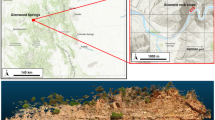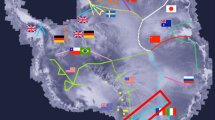Abstract
In this study, the spatio-temporal evolution of Yellowstone deformation between 1992 and 2009 is monitored using interferometric synthetic aperture radar (InSAR) data acquired by the European Remote-Sensing Satellites (ERS-1 and ERS-2) and the Environmental Satellite (ENVISAT). These data are combined with continuous global positioning system (GPS) measurements to identify four discrete episodes of caldera subsidence and uplift, these episodes are: 1992–1995 (subsidence of 2.7 cm/year), 1996–2000 (subsidence of 0.5 cm/year, with local uplift of 1.7 cm/year at Norris), 2000–2004 (subsidence of 0.7 cm/year, with local uplift of 0.6 cm/year at Norris), and 2004–2009 (uplift of 3–8 cm/year, with local subsidence of 1–4 cm/year at Norris). We construct the full three-dimensional velocity field of Yellowstone deformation for 2005–2006 from ascending and descending ENVISAT orbits. The InSAR three-dimensional velocity field and three-component GPS measurements indicate that the majority of the observed deformation (3–8 cm/year) across the Yellowstone caldera and near Norris Geyser Basin (NGB) occurred in the vertical direction between the summers of 2005 and 2006. During this time, significant lateral displacements of 3–7 cm/year also occurred in the east–west direction at the southeastern and western rims of the Yellowstone caldera and in the area between Hebgen Lake and NGB. Minor north–south displacements of about 0.2 cm/year also occurred, however, in the southwestern section of the caldera and near Yellowstone Lake during the same period. The calculated three-dimensional velocity field for 2005–2006 implies the existence of two pressure-point sources, beneath the two structural resurgent domes in the Yellowstone caldera, connected by a planar conduit, rather than a single, large sill as proposed in previous studies. Furthermore, no measurable displacements occurred along any fault zone across the caldera during the entire period of observation (1992–2009). Therefore, we infer that magmatic and hydrothermal processes beneath the Yellowstone caldera and NGB were the main sources of deformation.








Similar content being viewed by others
References
Aly MH, Rodgers DW, Thackray GD, Hughes SS (2009) Recent magmatotectonic activity in the eastern Snake River Plain—Island Park region revealed by SAR interferometry. J Volcanol Geotherm. doi:10.1016/j.jvolgeores.2009.05.015
Aubert M, Diliberto S, Finizola A, Chébli Y (2005) Double origin of hydrothermal convective flux variations in the Fossa of Vulcano (Italy). Bull Volcanol 70(6):743–751. doi:10.1007/s00445-007-0165-y
Blatt H, Tracy RJ, Owens BE (2006) Petrology: igneous, sedimentary, and metamorphic. Macmillan, NY
Chang W, Smith RB, Wicks C, Farrell JM, Puskas, CM (2007) Accelerated uplift and magmatic intrusion of the Yellowstone Caldera, 2004 to 2006. Science 318 (952). doi:10.1126/science.1146842
Christiansen RL (2001) The Quaternary and Pliocene Yellowstone Plateau volcanic field of Wyoming, Idaho, and Montana. US Geol Surv Prof Pap 729-G
Christiansen RL, Lowenstern JB, Smith RB, Heasler H, Morgan LA, Nathenson M, Mastin LG, Muffler LJP, Robinson JE (2007) Preliminary assessment of volcanic and hydrothermal hazards in Yellowstone National Park and vicinity. U.S. Geological Survey Open-File Report 2007–1071
Dieterich JH, Decker RW (1975) Finite element modeling of surface deformation associated with volcanism. J Geophys Res 80:4094–4102
Dzurisin D, Yamashita KM (1987) Vertical surface displacements at Yellowstone caldera, Wyoming. J Geophys Res 92:753–766
Dzurisin D, Savage JC, Fournier RO (1990) Recent crustal subsidence at Yellowstone caldera, Wyoming. Bull Volcanol 52:247–270
Dzurisin D, Yamashita KM, Kleinman JW (1994) Mechanisms of crustal uplift and subsidence at the Yellowstone caldera, Wyoming. Bull Volcanol 56:261–270
Dzurisin D, Wicks C, Thatcher W (1999) Renewed uplift at the Yellowstone Caldera measured by leveling surveys and satellite radar interferometry. Bull Volcanol 61:349–355
Fialko Y (2004) Probing the mechanical properties of seismically active crust with space geodesy: study of the co-seismic deformation due to the 1992 Mw7.3 Landers (southern California) earthquake. J Geophys Res 109. doi:10.1029/2003JB002756
Fialko Y, Simons M, Khazan Y (2001a) Finite source modeling of magmatic unrest in Socorro, New Mexico, and Long Valley, California. Geophys J Int 146(1):191–200
Fialko Y, Simons M, Agnew D (2001b) The complete (3-D) surface displacement field in the epicentral area of the 1999 Mw 7.1 Hector Mine earthquake, California, from space geodetic observations. Geophys Res Lett 28(16):3063–3066
Gabriel A, Goldstein R, Zebker H (1989) Mapping small elevation changes over large areas—differential radar interferometry. J Geophys Res 94:9183–9191
Gottsmann J, Folch A, Rymer H (2006) Unrest at Campi Flegrei: a contribution to the magmatic versus hydrothermal debate from inverse and finite element modeling. J Geophys Res 111:B07203. doi:10.1029/2005JB003745
Guilbert JM, Park CE (2007) The geology of ore deposits. Waveland, Long Grove
Hoffmann J, Galloway DL, Zebker HA (2003) Inverse modeling of interbed storage parameters using land subsidence observations, Antelope Valley, California. Water Resour Res 39(2):1031. doi:10.1029/2001WR001252
Hofmann-Wellenhof B, Lichtenegger H, Collins J (1992) Global positioning system: theory and practice. Springer, NY
Hurwitz S, Christiansen LB, Hsieh PA (2007) Hydrothermal fluid flow and deformation in large calderas: influences from numerical simulations. J Geophys Res 112:B02206. doi:10.1029/2006JB004689
Massonnet D, Feigl K (1995) Discrimination of geophysical phenomena in satellite radar interferograms. Geophys Res Lett 22(12):1537–1540
Meertens CM, Smith RB (1991) Crustal deformation of the Yellowstone caldera from first GPS measurements: 1987–1989. Geophys Res Lett 18(9):1763–1766
Meertens CM, Smith RB, Puskas CM (2000) Crustal deformation of the Yellowstone caldera from campaign and continuous GPS surveys, 1987–2000. Eos 81:V22F-19
Mogi K (1958) Relations between the eruptions of various volcanoes and the deformations of the ground surface around them. Bull Earthquake Res Inst Univ Tokyo 36:99–134
Okada Y (1985) Surface deformation due to shear and tensile faults in a halfspace. Bull Seismol Soc Am 75:1135–1154
Okada Y (1992) Internal deformation due to shear and tensile faults in a half-space. Bull Seismol Soc Am 82:1018–1040
Peltier A, Hurst T, Scott B, Cayol V (2009) Structures involved in the vertical deformation at Lake Taupo (New Zealand) between 1979 and 2007: new insights from numerical modeling. J Volcanol Geotherm 181:173–184
Pelton JR, Smith RB (1979) Recent crustal uplift in Yellowstone National Park. Science 206:1179–1182
Pelton JR, Smith RB (1982) Contemporary vertical surface displacements in Yellowstone National Park. J Geophys Res 87:2745–2761
Puskas C, Smith RB, Meertens CM, Chang WL (2007) Crustal deformation of the Yellowstone-Snake River Plain volcano-tectonic system: campaign and continuous GPS observations, 1987–2004. J Geophys Res 112:B03401. doi:10.1029/2006JB004325
Rinaldi AP, Todesco M, Bonafede M (2010) Hydrothermal instability and ground displacement at the Campi Flegrei caldera. Phys Earth Planet Inter 178:155–161
Sandwell DT, Sichoix L, Smith B (2002) The 1999 Hector Mine earthquake, Southern California: vector near-filed displacements from ERS InSAR. Bull Seismol Soc Am 92(4):1341–1354
Savage JC, Lisowski M, Prescott WH, Pitt AM (1993) Deformation from 1973 to 1987 in the epicentral area of the 1959 Hebgen Lake, Montana, earthquake (Ms = 7.5). J Geophys Res 98:2145–2153
Segall P (2010) Earthquake and volcano deformation. Princeton University Press, Princeton
Simons M, Fialko Y, Rivera L (2002) Coseismic deformation from the 1999 Mw 7.1 Hector Mine, California, earthquake, as inferred from InSAR and GPS observations. Bull Seismol Soc Am 92:1390–1402
U.S. Geological Survey (2006) Quaternary fault and fold database for the United States. http//earthquakes.usgs.gov/regional/qfaults/. Cited 21 Mar 2009
Vasco DW, Puskas CM, Smith RB, Meertens CM (2007) Crustal deformation and source models of the Yellowstone volcanic field from geodetic data. J Geophys Res 112:B07402. doi:10.1029/2006JB004641
Waite GP, Smith RB (2002) Seismic evidence for fluid migration accompanying subsidence of the Yellowstone caldera. J Geophys Res 107:2177. doi:10.1029/2001JB000586
Wessel P, Smith WHF (1995) New version of the Generic Mapping Tools released. EOS Trans Am Geophys Union (76)329
Wicks C, Thatcher W, Dzurisin D (1998) Migration of fluids beneath Yellowstone Caldera inferred from satellite radar interferometry. Science 282:458–462
Wicks C, Thatcher W, Dzurisin D, Svarc J (2006) Uplift, thermal unrest, and magma intrusion at Yellowstone Caldera. Nature 440:72–75
Wright TJ, Parsons BE, Lu Z (2004) Toward mapping surface deformation in three dimensions using InSAR. Geophys Res Lett 31:L01607. doi:10.1029/2003GL018827
Yun S, Segall P, Zebker H (2005) Constraints on magma chamber geometry at Sierra Negra Volcano Galapagos Islands, based on InSAR observations. J Volcanol Geotherm. doi:10.1016/j.jvolgeores.2005.07.009
Zebker H, Rosen P, Hensley S (1997) Atmospheric effects in interferometric synthetic aperture radar surface deformation and topographic maps. J Geophys Res 102(B4):7547–7563
Acknowledgments
The ERS and ENVISAT data were provided by the European Space Agency through the GeoEarthScope Program and the Western North America Interferometric Synthetic Aperture Radar Consortium with funding from NASA, NSF, and USGS. The SRTM data were obtained from NASA JPL. The manuscript has been improved significantly with thoughtful reviews and constructive comments by James White, Andrew Harris, Lisa Morgan, and an anonymous reviewer.
Author information
Authors and Affiliations
Corresponding author
Additional information
Editorial responsibility: A. Harris
Rights and permissions
About this article
Cite this article
Aly, M.H., Cochran, E.S. Spatio-temporal evolution of Yellowstone deformation between 1992 and 2009 from InSAR and GPS observations. Bull Volcanol 73, 1407–1419 (2011). https://doi.org/10.1007/s00445-011-0483-y
Received:
Accepted:
Published:
Issue Date:
DOI: https://doi.org/10.1007/s00445-011-0483-y




